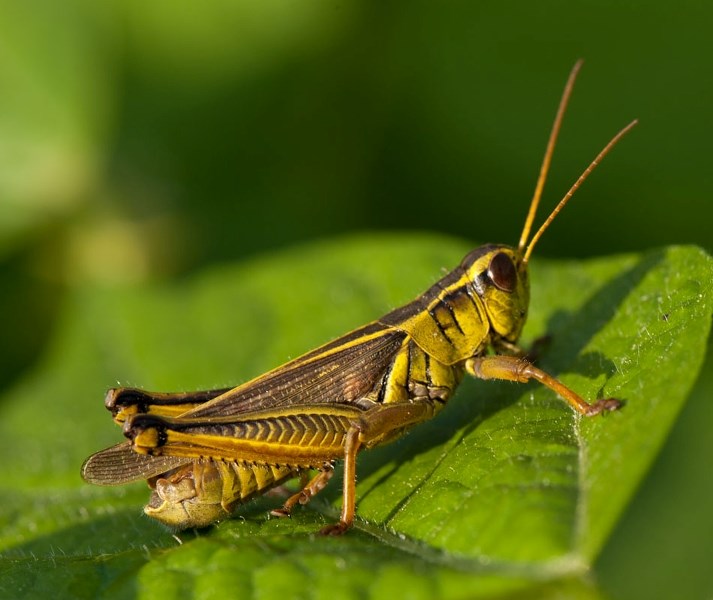Alberta's dry summer has turned what should have been a blah year for grasshoppers into a boom, say local bug-watchers – a boom that, for now, seems to have missed the St. Albert region.
Residents walking through any stretch of grass recently might have noticed the hordes of grasshoppers springing away from them with every step.
While grasshoppers are reportedly running rampant west of Edmonton and in parts of northern Alberta, they aren't anywhere near as numerous here in town as they were back in 2009, says Mike Jenkins, biological science technician (bug guy) for the City of Edmonton.
"It's generally not a major pest issue for people living in the city," he says of grasshoppers.
St. Albert environment manager Mike Mellross also says he hadn't heard of any grasshopper issues in town this week.
It's all-quiet on the county front as well, reports André Montpetit, whose crews at Sturgeon Valley Fertilizer do most of the bug-spraying in Sturgeon County. There are definitely grasshoppers in the fields, but few if any farmers are spraying for them as they've yet to hit the economic threshold for pesticide use.
"There's a lot of bugs everywhere," he notes, including ants and lygus bugs.
This year shouldn't have been a great one for grasshoppers, as they generally didn't lay a lot of eggs last year, says Dan Johnson, an entomologist at the University of Lethbridge who studies grasshoppers. The high heat has helped most of those eggs hatch, however, causing areas that had a mere one or two hoppers per square metre last year to have up to 10 this year.
"It's not really an outbreak, but it's on the way up."
The usual hoppers
While there are about 80 species of grasshopper on the prairies, you're most likely to see just three of them around St. Albert, says Peter Heule, entomologist with the Royal Alberta Museum.
The most common is likely the two-striped grasshopper. A two-to-three centimetre long greenish-yellow beast, it enjoys long hops along the roadside and meals of weeds and alfalfa, making it a pest in some circumstances. Look for a pair of white or beige stripes on its back that run from its eyes to its wings.
If it's got black-striped thighs, you've probably got a migratory grasshopper, Heule says – another pest species. A voracious eater, these grasshoppers prefer ditches and stubble fields, and are typically a mix of brown and yellow. Some also have red legs, which is why they're also called red-legged grasshoppers.
The last and biggest is the Carolina grasshopper, or road duster. Desert-tan in colour and the length of your thumb, these urban ninjas are experts at blending into the background, only to leap up right next to you as they clack like water sprinklers and flash their black, white-edged wings.
"They're super well camouflaged," Heule says.
"You might not even see them until you almost step on them."
Grasshoppers thrive in hot, dry conditions, Johnson says – some don't even drink, getting all their water from their food.
"The preferred body temperature for many grasshoppers is around 38 C," he continues – he's seen some sun-tanning on 50 C surfaces.
Johnson says grasshoppers have five eyes with which to see the world: two big compound ones, two smaller ones and a fifth in the centre of their forehead. Able to see colour and the edges of objects, they use their eyes and abdomen-mounted ears to detect threats and their powerful legs to leap away from them.
Dry conditions have made for less-filling crops, meaning that grasshoppers may be more ravenous this year than in the past, Heule says.
The dryness has also lessened the power of a certain fungus known to turn grasshoppers into zombies. Grasshoppers infested with entomophthora grylli become influenced to lock their legs around the tips of grass stems until they die, say Jenkins and Johnson. Once that happens, the fungus produces tiny water cannons to shoot spore-shot to the seven winds.
Birds, spiders, and garter snakes are all still around and hungry for hoppers, though, notes Heule.
"They're a very important part of the food chain."




